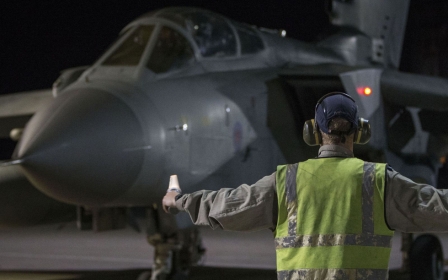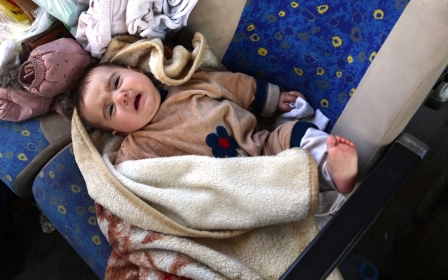Syrian government continues to injure, kill civilians in rebel areas

A day after US President Donald Trump declared "mission accomplished", the Syrian government continued to injure and kill its civilians with strikes in rebel-held areas across Syria.
Local activists in Idlib and Homs told Middle East Eye that air strikes and shelling resumed on Sunday and continued until Monday, after America said it was "locked and loaded" if President Bashar al-Assad used chemical weapons again.
Monitoring groups and rescue volunteers had said that many were injured with at least one person killed from the renewed shelling and strikes in the northern Homs countryside.
We prefer to be killed from chemical attacks because at least our bodies remain intact
- Saleh Daheik, media activist
Asinat al-Riz, a young girl, was killed in the outskirts of Al-Rastan on Sunday, a town in the northern Homs countryside, according to the Syrian Civil Defence rescue group.
The group said Al-Riz died after "continuous artillery shelling and air raids on the area".
The UK based Syrian Observatory for Human Rights also confirmed Al-Riz's death and said that the Syrian government had resumed shelling and air strikes on Sunday in the northern Homs countryside.
The monitoring group said that 25 air raids had also taken place on Sunday in the village of Ezzedin, in north-eastern Homs.
Saleh Daheik, a media activist with Balady news who lives in the Homs countryside, told Middle East Eye that an air strike had hit the villages of Deir Foul and Ezzedin in the northern Homs countryside on Sunday.
"Six people were injured including children and women on Monday after a funeral tent of someone who died yesterday [after being] targeted with artillery shells," said Daheik.
Bombed air base in use
The media activist claimed that the warplanes had taken off from the Al Shayrat or the Tiyas airbase in Homs controlled by the Syrian government.
"We know they took off from these airbases because, for the last six years, we have had wireless devices that can listen in on regime forces.
"We also listen in on the movement from these bases and tapping into their operations rooms, so that we can warn civilians before the planes fly out and attack villages."
The Tiyas airbase, also known as the T4 airbase, was hit by Israeli air strikes last week after it claimed that Iranian drones had operated from the base.
A senior Israeli military official on Monday confirmed to the New York Times that it targeted the T4 airbase and said that it was the first time Israel targeted "live Iranian targets".
Khaldoun Barakat, who lives in Al-Rastan also said that jets had flown past her home, towards the northern Homs countryside.
"In the last two days, we have heard a group of jets flying over us in the area surrounding the Homs countryside," said Barakat, who lives near Khan Sheikhoun, where a previous chemical attack took place in 2017.
"It was horrific seeing such a vast number of planes flying so close to us, especially after more than a year of peace and agreements with the regime to stop fighting in this area.
"We hoped that after the US attacks, the regime would stop its attacks against Syrian rebel areas."
The Homs countryside alongside parts of Idlib and Hama are some of the last remaining rebel-held areas left in Syria.
Earlier this year, senior Arab officials in Amman, Jordan, and Beirut described conditions in Idlib as a "kill box" as refugees continued to pour into the rebel area.
Syrians in rebel areas have welcomed the US strikes on Bashar al Assad's forces, but many have questioned the long-term benefit of the attacks.
"We hoped that the strikes would be continuous until they bring down Assad's regime, and not just strikes to stop him using chemical weapons," said Daheik.
"We prefer to be killed from chemical attacks because at least our bodies remain intact. But the regime attacks us with all types of weapons; we see bloody, body parts, and casualties. Scenes that are difficult to explain."
Additional reporting by Arij Limam.
New MEE newsletter: Jerusalem Dispatch
Sign up to get the latest insights and analysis on Israel-Palestine, alongside Turkey Unpacked and other MEE newsletters
Middle East Eye delivers independent and unrivalled coverage and analysis of the Middle East, North Africa and beyond. To learn more about republishing this content and the associated fees, please fill out this form. More about MEE can be found here.




